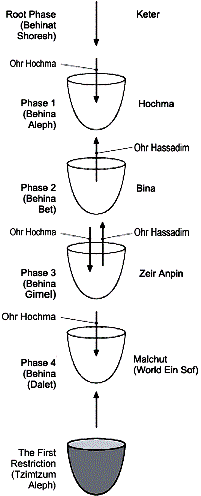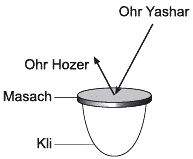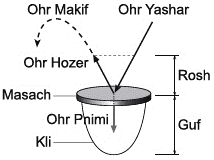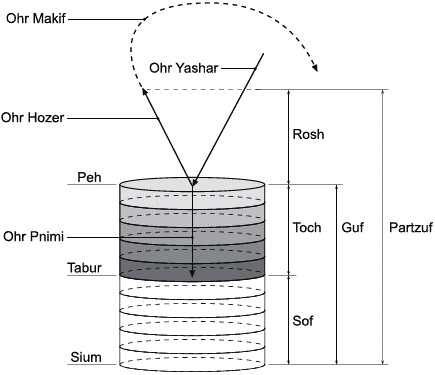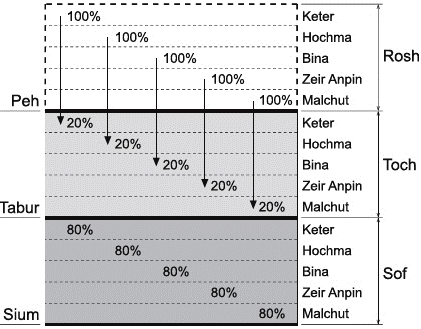Chapter 3.6 - The First Restriction, Screen, Partzuf
When the Light of Wisdom fills up the will to receive in the first phase, it also gives it its nature–that of bestowal. That is why in the end, after having felt the nature of the Light that fills it, the first phase changes its desire from that of reception to that of bestowal.
The Light works the same way in the fourth phase once it exits the third phase after having filled itself with Light of Wisdom. Then it, too, begins to want to give, like the nature of the Light inside it. As a result, the desire to receive disappears from the fourth phase.
The Light gives the vessel its desire to bestow when it fills up the vessel because the vessel feels not only the pleasure from the Light, but the desire of the giver as well. The Creator could have created a vessel that would not feel Him as a giver, but only the pleasure at reception. That’s how those with an undeveloped will to receive and children feel in our world, as well as insensitive and mentally unstable individuals.
Once we grow from children to adults, we become ashamed to receive. That sensation is so developed in us that we would choose any pain in the world over the pain of shame. This attribute was created by the Creator so that we would be able to use it to rise above our nature, which is the will to receive.
In order to be ashamed to receive, we must feel that we are receiving. That is possible only if there is a giver and we feel His existence. If I don’t feel the Host, I will not be ashamed. But if He’s standing right in front of me, then I will be ashamed. I cannot receive directly; because I have to relate to Him, give Him something in return for what I receive, which turns it into a tradeoff rather than mere reception. Then I, too, become a giver, because he too receives from me.
The sensation of the Creator awakens in Malchut such intense pain when it is received that it decides never again to use its will to receive pleasure for itself. This decision is called "Restriction." The name "First Restriction” indicates that this is the first time something like this happens.
The Progression of Light Leading to the Restriction
By not receiving Light, Malchut stops being the receiver, but she still gives nothing to the Creator; she still does not attain her desire to be like the Light, the giver of the pleasure. By not receiving pleasure from the Creator, Malchut does not attain the equivalence of form. Thus we see that the First Restriction is not an end, but a means to acquire the ability to give.
The purpose of the Creator in Creation was that Malchut, the creature, would receive pleasure. That Thought of Creation is unchanging. Because of that, the Creator continues to pressure Malchut to receive it. Malchut feels that the restriction is not enough to attain the
status of The Giver, but how can the creature, whose only attribute is that of reception, give
By feeling its Upper Nine attributes (the attributes of the Creator that Malchut feels within), which comprise the way the Creator relates to Malchut, it begins to understand how it can give back to the Creator. It decides that if it would receive the Light and enjoy it because the Creator enjoys its delight, then that would make its reception tantamount to bestowal.
The reception of pleasure by the receiver in order to please the giver turns an act of reception into one of bestowal. If Malchut receives the entire Light (pleasure) that the Creator had prepared for it, then it will give the Creator just as much as He is giving Malchut.
For example: there is a guest and a host. The host treats his guest with delicacies the guest would love to have. (The desire is in perfect fit with the Light in both quantity and quality, because the pleasure-light created the vessel-desire this way). But although the guest is very hungry, the presence of the host makes him feel ashamed, and that stops him from eating. The shame stems from the fact that he feels himself as a receiver, and the host as a giver. The shame is so strong that he can no longer eat.
But the constant pleas of the host, who have prepared it all for him, finally persuade him that the host will enjoy it if he eats. Then the guest thinks that if now, after having rejected the pleasure several times, he will agree to eat, it will be considered a favor to the host. In this way, he will become the giver, and the host, the receiver.
The hunger and the desire to receive delight and pleasure are referred to in Kabbalah as a "vessel." The pleasure emanating from the Creator is called Direct Light, and the power to reject it is called a "screen." The Light that is rejected from the screen is then referred to as Returning Light. With the power of the screen; i.e., the force to reject enjoying for self and taking pleasure only for the Creator, the vessel can face its own will to receive. One might understand that the vessel rejects the Light, but it would be more accurate to say that the vessel rejects the use of the desire in order to please itself.
The Screen Rejecting the Light
The vessel cannot return Light to the Creator, but only change the intention. The intention to delight the Creator, what we call "the Returning Light," is only synonym for pleasure. Direct light is tantamount to the pleasure that the Creator wants to render the creature. Returning Light is the pleasure that the creature wants to give the Creator.
Once the vessel (guest) is certain that he will not receive itself, it examines the magnitude
Kabbalists are people who feel the Light that comes from the Creator and every action He performs, but when they write about spirituality, they convey their feelings in technical terms. Therefore, if the reader has the screen and the strength the books describe, he or she can translate the words into feelings by repeating the same actions described in their books.
The Light stems directly from the Creator, hence the name, "Direct Light," and wants to dress the vessel, but then it collides with the screen. When the screen rejects the Light, refusing to receive it in order to receive, the vessel asserts the limitation of the First Restriction, which is to not receive for itself. Once the vessel is certain it will not receive for itself, it calculates how much it can receive in order to bestow (delight the Creator). Sensing the Light and the calculating how much of it to receive is done prior to actually receiving it. The part that decides and plans this is called Rosh (Head), and the place where the screen is located is called Peh (mouth).
After the decision in the Rosh has been made, the vessel receives the Light into the part called Toch (inside, interior). This is the part of the vessel where the reception is actually
In Kabbalistic terms it would sound like this: Direct Light clothes the Returning Light, and the Light of Wisdom clothes the Light of Mercy.
The vessel can receive only a small portion of the Light that stems from the Creator because the screen doesn’t have sufficient strength to receive all of it. That is why there is a part in it that is filled with pleasure and a part that remains empty. The part that remains empty is called Sof (End). We can now see that the creature is comprised of three parts: Rosh, Toch, Sof. Together they comprise what we call a Partzuf (Face). The Guf (Body) of the Partzuf (all its desires) is divided into Toch, which receives Light, and Sof, which remains empty.
The border inside the Guf (Body) of the Partzuf, where the Light stops, is called Tabur (Navel). The Light that is received inside the Partzuf is called "Inner Light."
The part that remains outside the Partzuf is called "Surrounding Light."
Direct Light is divided by the screen into Inner and Surrounding Lights.
Malchut consists of five phases. The screen decides how much to receive in each phase. Each phase is then divided into a part that receives and a part that does not, which is why there are five phases in the Toch and five in the Sof.
Summary: When the Light corrects the vessel, it gives it the Will of the Creator. That is actually what we need, for the Light to come (the very same Surrounding Light that we awaken during the study if we want to attain the purpose of Creation) and correct us to want to emulate the Creator in everything we do, meaning to bestow. That is the uniqueness of the Kabbalah, and that is its importance. The study awakens the Surrounding Light that corrects man.
